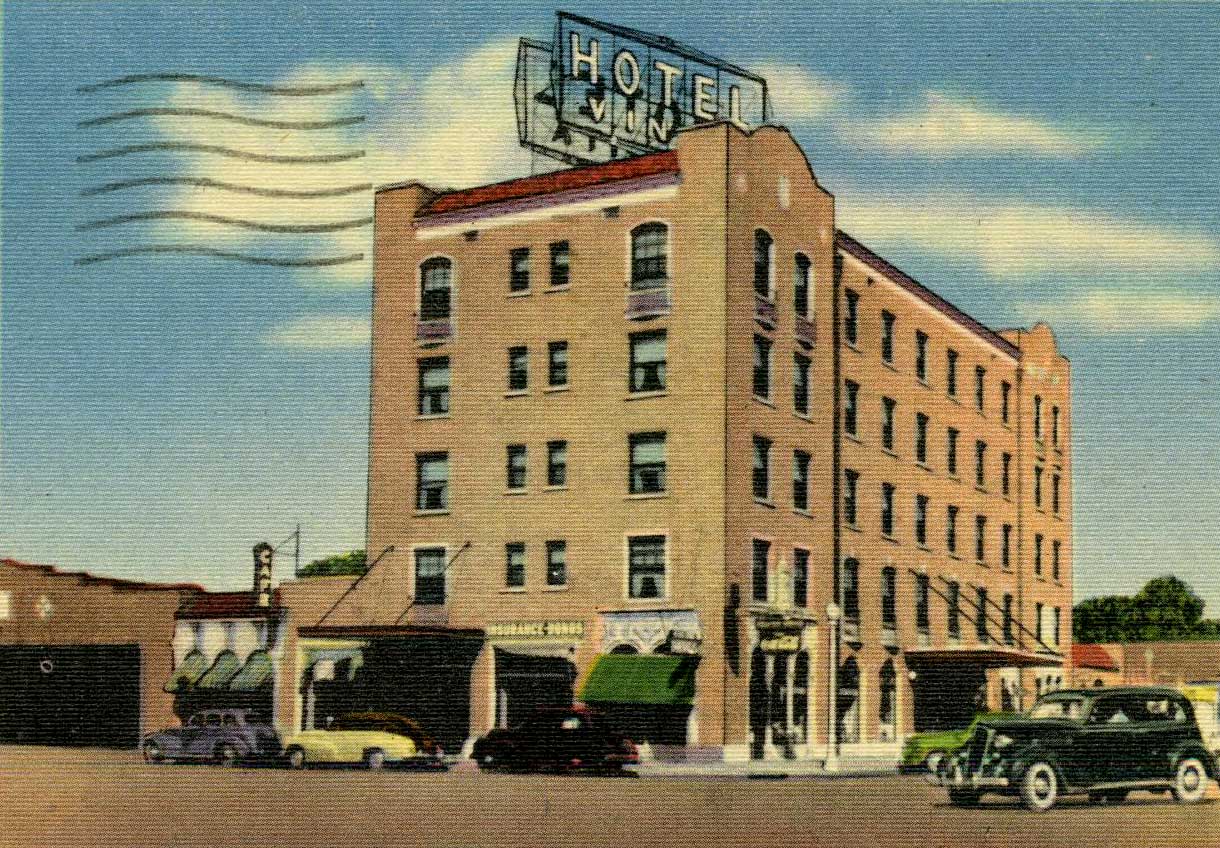
VINITA.
Located in south-central Craig County and its seat of government, Vinita is approximately sixty miles northeast of Tulsa and sixty miles southwest of Joplin, Missouri. U.S. Highways 60 and 69, and State Highways 2 and 66 intersect at Vinita, and Interstate Highway 44, the Will Rogers Turnpike, passes along the city's east side. Two major railroads, the Burlington Northern Santa Fe and the Union Pacific, also cross in Vinita.
Vinita's original site was about two miles south of the present town, on the Missouri, Kansas and Texas Railway (Katy, now the Union Pacific) and within the Cherokee Nation's Cooweescoowee District. Elias C. Boudinot founded the town and named it for his friend, sculptor Vinnie Ream. However, Johnson Thompson and other Cherokees persuaded the Atlantic and Pacific Railroad (now the Burlington Northern Santa Fe Railroad) to reroute their tracks north to cross the Katy's at the town's present location, at the time called "the Junction" or "Downingville." Boudinot managed to later change the name to Vinita. In 1872 the sale of lots began. Vinita was the second Cherokee town to incorporate under a law passed by the Cherokee Council. In 1898, after the United States passed the Curtis Act, abolishing tribal courts, Vinita incorporated under Arkansas law, which the U.S. government had extended over the territory.
According to a report of the U.S. Commissioner of Indian Affairs by 1866 Vinita's population had grown to one thousand. In 1892 the First National Bank, one of the oldest banks in Indian Territory, was established. In 1894 Masonic Lodge no. 5 was founded. Ranching played an important role in the area's economy. From 1902 to 1907 Vinita served as the seat of the Northern District Federal Court. In 1907, when Craig County was created, Vinita became the governmental center. The Vinita Indian Chieftain, the first newspaper, began publication in 1882, and the Daily Indian Chieftain was added in 1899. The Vinita Leader first appeared in 1895. In 1907 the Vinita Daily Journal began and remained in publication at the beginning of the twenty-first century. Several other newspapers have also served residents.
A variety of businesses and facilities provided employment. In 1935 the Grand River Dam Authority established the Pensacola Dam on the Grand River, creating the Grand Lake O' the Cherokees. The Kansas, Arkansas, Missouri, and Oklahoma Electric Company (KAMO) and Northeast Oklahoma Electric Cooperative Association, which developed as a result of the building of the dam, maintain significant operations in Vinita. Other important employers have included trucking companies, tower-building companies, Munsingwear, General Mills, Cinch, Dana Industries, and Hope Industries, which is affiliated with the Home of Hope for the mentally disabled. A McDonald's, one of the chain's largest stores, occupies the Glass House Restaurant, built over the Will Rogers Turnpike. A Harvey House restaurant stood beside the railroad for a number of years. During World War II Burke Aviation operated a glider school in Vinita and between September 1942 and March 1943 trained 225 cadets.
In 1912 Eastern State Hospital, a mental health center, was built on the northeast edge of town. In January 1913 the first patients arrived. This facility was one of the county's largest employers until its operations were reduced in the late 1990s. In 2003 a new Oklahoma Department of Corrections facility occupied part of state hospital's land.
Educational institutions have remained important. Worcester Academy was established in 1883. Galloway College was founded in 1888 and was renamed in 1891 for Willie Edna Halsell, daughter of rancher W. E. Halsell. In 1897 the Catholic Church established Sacred Heart Academy, a boarding school that continued operation until 1968. Attucks was a separate school for African American students. At the end of the twentieth century Vinita Public Schools accommodated about eighteen hundred students in grades preschool through twelve.
Will Rogers, who attended Worcester Academy and Willie Halsell College, suggested the idea of a local rodeo, and the Will Rogers Memorial Rodeo began in 1935. Lucien (Hoolie) Bell, a lawyer and member of the Sequoyah Constitutional Convention, and Ballerina Yvonne Chouteau were Vinita natives. Others with community ties are Cherokee Chief Thomas M. Buffington, Olympian Jeff Bennett, rodeo cowboy Tee Woolman, television show host Dr. Phil McGraw, former Illinois governor Jim Edgar, and Gene Autry, who lived in Vinita when discovered by Will Rogers.
In 1900 Vinita had 2,339 residents, fewer than the 3,157 reported at 1907 statehood. Thereafter, the town's population increased each decade until 1980. In 1910 it stood at 4,082, and in 1940 at 5,685. It rose to 6,740 in 1980 but declined to 6,472 in 2000 and to 5,743 in 2010. In April 2020 the U.S. Census reported a population of 5,193. A number of local properties have been listed in the National Register of Historic Places, including the Craig County Courthouse (NR 84002994), the First Methodist-Episcopal Church, South (NR 99000673), the Hotel Vinita (NR 94001608), the Randall Tire Company (NR 95000029), and the Spraker Service Station (NR 95000030). In 2003 the town maintained an aldermanic form of government.







